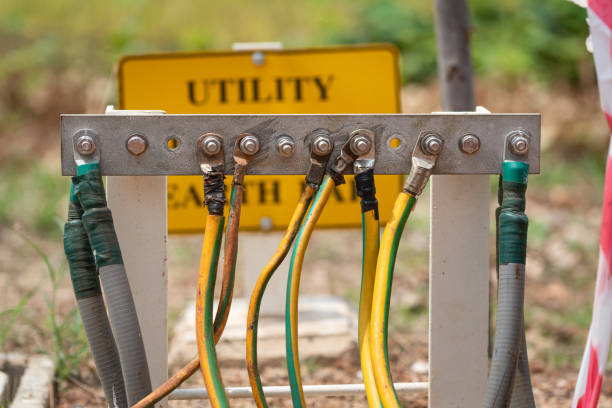An electrical earthing system is a critical component of any electrical installation, ensuring safety and reliability. In the UAE, where advanced infrastructure and high-rise buildings are common, a well-designed earthing system is essential to prevent electrical hazards. Electrical earthing system provides a path for fault currents to safely dissipate into the ground, reducing the risk of electric shock, equipment damage, and fire hazards. Understanding how an earthing system works, its types, and safety measures is crucial for electrical engineers, technicians, and property owners.
What is an Electrical Earthing System?
An electrical earthing system is a protective method that connects electrical installations and appliances to the earth using conductive materials like copper or galvanized steel. The primary purpose is to provide a low-resistance path for excess electricity, preventing dangerous voltage build-up in the system. It safeguards people, electrical equipment, and structures from potential damage caused by electrical faults or lightning strikes.
Importance of Electrical Earthing in the UAE
The UAE experiences extreme weather conditions, including lightning storms, which can cause electrical surges. Earthing plays a significant role in:
-
Preventing electric shocks by directing fault currents away from human contact.
-
Protecting electrical appliances from voltage fluctuations.
-
Reducing the risk of electrical fires caused by insulation failures.
-
Ensuring stable operation of electrical systems in commercial and residential buildings.
Types of Electrical Earthing Systems
Different types of earthing systems are used in the UAE, depending on the application and safety requirements. The most common types include:
1. Plate Earthing
Plate earthing involves burying a conductive metal plate (copper or galvanized iron) deep into the ground. This method provides a large surface area for dissipating fault currents effectively.
2. Pipe Earthing
This is one of the most widely used earthing methods. It consists of a metal pipe (usually galvanized steel or copper) inserted vertically into the ground. The moisture content in the soil helps maintain the conductivity, making it effective for high-rise buildings.
3. Rod Earthing
Rod earthing uses long copper or galvanized rods driven deep into the ground. It is a cost-effective method used in areas where soil resistivity is low, ensuring effective current dissipation.
4. Strip or Wire Earthing
In this method, a strip or wire made of copper or galvanized steel is buried in a horizontal trench. It is commonly used for industrial plants and transmission towers to provide a stable grounding system.
5. Earthing in High-Rise Buildings
With the increasing number of skyscrapers in cities like Dubai and Abu Dhabi, earthing systems for high-rise buildings include multiple interconnected ground rods and conductive grounding mats to ensure complete safety and reliability.
How Electrical Earthing Works
The working principle of an electrical earthing system is based on the concept of low-resistance grounding. When a fault occurs in an electrical circuit, excess electricity flows through the earthing conductor and dissipates safely into the ground. This prevents electrical shocks, equipment failure, and fire hazards.
The main components of an earthing system include:
-
Earth Electrodes: Conductive materials (rods, plates, or pipes) buried underground.
-
Earth Conductors: Wires or strips connecting electrical systems to the electrodes.
-
Grounding Resistance: Measures how well the earth electrode disperses the current.
Safety Measures for Electrical Earthing in the UAE
To ensure an effective and safe earthing system, the following safety measures must be followed:
1. Proper Selection of Earthing Material
Using high-quality copper or galvanized steel conductors improves conductivity and longevity.
2. Regular Testing and Maintenance
Periodic earth resistance testing should be conducted to check the efficiency of the system. If resistance levels are too high, corrective actions such as adding salt and charcoal to the soil should be taken.
3. Compliance with UAE Electrical Standards
All earthing installations must comply with UAE regulations, including the DEWA (Dubai Electricity and Water Authority) and ADDC (Abu Dhabi Distribution Company) standards for electrical safety.
4. Moisture Control
Soil moisture affects grounding efficiency. In dry regions like the UAE, chemical grounding compounds can be used to maintain proper conductivity.
5. Surge Protection
Installing surge protection devices (SPDs) helps protect electrical systems from transient voltage surges due to lightning or grid fluctuations.
Common Issues in Electrical Earthing Systems
Despite proper installation, some issues may arise in earthing systems, such as:
-
Corrosion of earthing rods or plates due to soil conditions.
-
High soil resistivity affecting grounding efficiency.
-
Loose or damaged connections reducing system effectiveness.
Regular inspections and maintenance can help identify and fix these problems before they lead to electrical failures.
Conclusion
A well-designed electrical earthing system is essential for safety and efficiency in the UAE. With increasing urbanization and reliance on advanced electrical systems, proper earthing ensures protection against electrical hazards, equipment damage, and fire risks. Understanding the working principles, types, and safety measures of earthing systems helps maintain secure and reliable electrical infrastructure. Regular maintenance and adherence to UAE safety standards further enhance the effectiveness of earthing systems.








